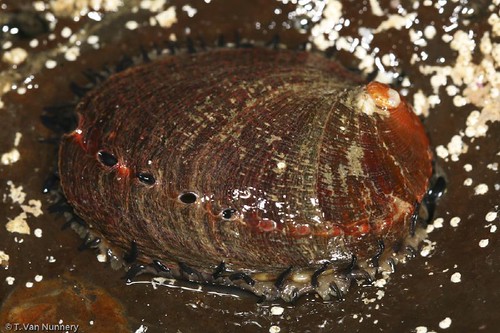Red Abalone - Haliotis rufescens
The characteristic red abalone with its reddish shell, 3-4 open ports in the shell,black or black and cream epipodium, and black tentacles. This one is starting a new shell port and closing up the oldest still open one at the same time. You can see the even older ports which have been sealed with shell, spiraling back to the oldest part of the shell on the the left of the picture. The holes are used for respiration and sanitation. Yes, that means it poops and breathes through the same shell holes. It also releases eggs or sperm (abalone have separate sexes) to the water column during broadcast spawning sessions through the same holes. A great page on the general biology of abalone, including dissection, cleaning and cooking is available at MarineBio.net.
If you're eating abalone from the United States, the Red Abalone, Halioti rufescens is the one you're likely having. It's a good seafood choice too, since it comes from an aquaculture operation. Monterey Bay Aquarium's Seafood Watch program lists farmed abalone a Best Choice. There is very limited recreational fishing for H. rufescens in Northern California, and all commercial fisheries for abalone in the United States were closed in the 1990's, so it is the red abalone aquaculture operations of California and Mexico that are the core of the U.S. abalone market. That aquaculture (and fishery) interest is also a big driver for gaining more knowledge of the general biology, reproduction and larval success factors etc to improve culturing and aquaculture success as well as wild stock conservation.
As a kid I spent a lot of time just North of Santa Barbara, California. One of my favorite things to do, naturally enough, was to head to the beach. Especially the rocky coast just north of the Pt. Conception lighthouse where we would examine the tide pools and sometimes, when in season, pick abalone for dinner as a treat. I have to admit I love eating abalone.
We would take a 9+ inch (~230mm) abalone from time to time, though the norm was more around 8-9 inches (200-230mm). Turns out that is quite a catch by today's standard when wild picked (shore accessible), as I understand it, average only just over 7 inches (175mm), which is also the minimum catch size. You might think that a one inch difference in size is not that big a change for 30+ years, but it can represent a dramatic age difference in the animal.
After making it through two lecithotrophic (yolk absorbing) larval stages, juveniles settle and begin feeding on diatoms and other microflora on benthic surfaces. After six months they will be between 1/4 and 1/2 inches across (at the widest point) and transition to begin feeding more on macroalgae. By three years old they are 2 inches across or more. At 5 years old they will have attained a 4 inch shell, the size that farm raised abalone are generally taken at.
By the time the abalone are 6" long they are 9 years old and females are reaching peak fecundity. To reach the 7" recreational fisheries limit requires another 3 years of growth. The next inch of growth requires another 6 years of healthy growing. Those 9 and 10" beauties we caught many years ago would have been 25 to 30 years old!
Trivia Note: It was the white abalone, that has the distinctly unenviable honor of becoming the first marine invertebrate to be listed as endangered under ESA.





















No comments:
Post a Comment
Note: Only a member of this blog may post a comment.